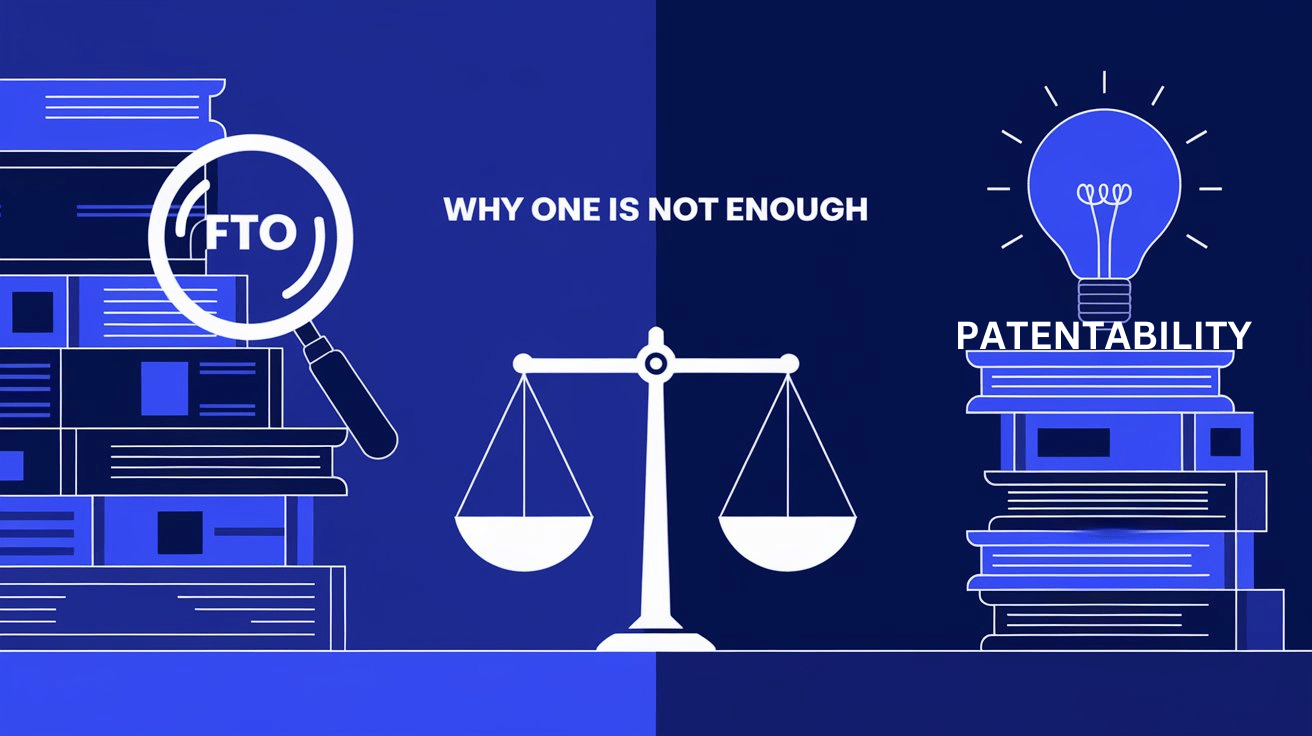MARCH 6, 2025
FTO Search vs. Patentability Search: Why One is Not Enough
In intellectual property (IP) strategy, two critical types of patent searches play distinct roles: Freedom-to-Operate (FTO) searches and Patentability searches. While both involve analyzing patents, they serve different legal and commercial purposes. Relying on one without the other can lead to legal risks, missed opportunities, or wasted R&D investment.
This article provides a technical comparison of FTO and patentability searches, detailing their methodologies, scope, limitations, and appropriate use cases.
Understanding the Fundamental Differences
In this section, you can address common questions efficiently.
Feature
Freedom-to-Operate (FTO) Search
Purpose
Determines if a product or process infringes existing patents
Scope
Active patents in specific jurisdictions
Legal Risk Focus
Infringement risk assessment
Outcome
Identifies barriers to commercialization
Coverage
Claims of granted patents
2. FTO Search: Scope and Technical Methodology
An FTO search aims to identify existing patents that could restrict the commercialization of a product, process, or technology.
Patent Claim Analysis: Focuses on the claims of live patents rather than full patent disclosures.
Jurisdiction-Specific: Only considers patents valid in the jurisdictions where commercialization is intended.
Legal Status Review: Determines whether a patent is active, expired, abandoned, or pending.
Assignee and Competitor Monitoring: Identifies patent holders who may pose infringement risks.
Claim Construction and Interpretation: Uses legal and technical analysis to evaluate scope.
Paid Tools: Derwent Innovation, PatBase, LexisNexis PatentSight, Orbit Intelligence.
Free Tools: Espacenet (EPO), USPTO Patent Database, Google Patents.
Cannot Ensure Complete Safety: Even a thorough FTO search cannot guarantee absolute non-infringement.
Focuses on Patents Only: Does not consider non-patent barriers (e.g., trade secrets, regulatory approvals).
Patentability Search: Scope and Technical Approach
1 Objective. A patentability search determines whether an invention meets the novelty, non-obviousness, and industrial applicability criteria for a patent grant.
2 Key Elements of a Patentability Search. Prior Art Analysis: Includes both patent and non-patent literature (NPL) (e.g., scientific papers, technical reports, existing products).
Prior Art Analysis: Includes both patent and non-patent literature (NPL) (e.g., scientific papers, technical reports, existing products). Global Scope: Searches across multiple jurisdictions to identify prior disclosures.
Global Scope: Searches across multiple jurisdictions to identify prior disclosures. Technical Field Coverage: Uses classification systems (CPC, IPC, USPC) for targeted search.
3 Tools and Databases for Patentability Searches. Paid Tools: PatSnap, Derwent Innovation, Orbit Intelligence, Innography.
Free Tools: Google Patents, USPTO, Espacenet, WIPO PATENTSCOPE, IEEE Xplore.
4 Limitations. Does Not Cover Legal Risks: Being patentable does not mean the invention is free to use (FTO is still required).
Prior Art Search Challenges: Some prior art may not be easily accessible (e.g., unpublished patents, trade secrets).
5 When to Conduct a Patentability Search. Before filing a patent application.
Before investing heavily in R&D.
4. Why Search Is Not Enough: The Real Need
1 Case Study: Pharmaceutical Industry
A company develops a new drug formulation and conducts a patentability search. The search confirms that the drug is novel and patentable. However, an FTO search later reveals that key formulation techniques are patented by competitors. Without an FTO search, the company could face infringement lawsuits despite owning a patent.
2 Case Study: Consumer Electronics
A startup designs a new wireless charging device and files a patent. A patentability search ensures the novelty of their design. After filing, they conduct an FTO search and discover that an active patent covers key aspects of wireless power transfer. The startup must now negotiate licensing agreements or modify its design to avoid infringement.
3 Key Takeaways
In this section, we'll highlight the most important concepts.
Scenario
Launching a product
FTO Search Needed?
Yes
Patentability Search Needed?
Yes
Filing a new patent
No
Licensing existing technology
Yes
Expanding into a new market
Yes
Patentability searches and FTO searches serve distinct but complementary roles. A robust IP strategy should integrate both to ensure that a company can secure patents while avoiding infringement risks.
Best Practice Recommendations:
Conduct a patentability search before filing a patent to ensure novelty and maximize protection scope. Perform an FTO search before commercialization to identify infringement risks and design-around opportunities. Consult IP attorneys to interpret search results and formulate a risk mitigation strategy.
By understanding the nuances of these two searches, companies can make informed decisions, mitigate legal risks, and enhance their innovation strategy in competitive markets.
Empowering Innovation: IP Brigade specialize in creating, managing, and monetizing intellectual property to fuel your success.

CONTACT US
+1-267-855-3990

Working Hours
Mon-Sat: 9:00 AM-6:00 PM

US Address
1401 E Bristol St Office #2 - V95, Philadelphia, PA 19124

India Address
Plot No. 15, Ground Floor, Sai Enclave, Sector 23, Dwarka, New Delhi, Delhi, 110077

Copyright © 2024 IP BRIGADE INC. All Rights Reserved.
info@ipbrigade.com

